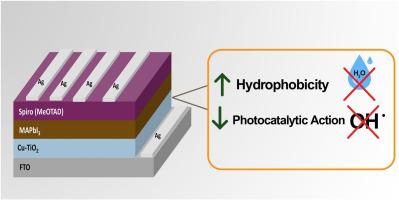Applied Catalysis B: Environment and Energy ( IF 20.2 ) Pub Date : 2020-11-21 , DOI: 10.1016/j.apcatb.2020.119714 Alaa A. Zaky , Eleftherios Christopoulos , Konstantina Gkini , Michalis K. Arfanis , Labrini Sygellou , Andreas Kaltzoglou , Anastasios Stergiou , Nikos Tagmatarchis , Nikolaos Balis , Polycarpos Falaras

|
The electron transport layer (ETL) plays a pivotal role in obtaining perovskite solar cells (PSCs) with high power conversion efficiency (PCE). Titanium dioxide is a widely used ETL, however it suffers from low electron mobility, poor conductivity and may act as a photocatalyst of chemical reactions leading to degradation of the perovskite. Herein, copper cations employed to modify the titania ETL of PSCs, mitigate the photocatalytic action of the compact layer, increase its conductivity and electron mobility, adjust favorably the energy levels, improve the ETL/perovskite interface, thus enhance perovskite’s light absorption and provoke passivation of the perovskite surface trap states. The investigation of structural and surface chemistry properties revealed the uniform distribution of Cu1+ in TiO2 and confirmed the determining role of copper in the fast extraction of the photogenerated charge carriers to the adjacent electrode. As a result, the champion planar PSCs based on the hydrophobic Cu-TiO2 ETL showed a 18.15 % PCE outperforming the reference devices (based on pristine TiO2 ETL) which showed a PCE equal to 15.78 %. The results followed the same trend also in the case of mesoporous PSCs, proving the universality of our approach. Finally, aging tests confirmed that the copper-modified devices showed higher stability in comparison with the non-modified ones retaining the 53 % of the initial PCE value after 51 days of storage in relative humidity (RH = 25 %) and dark conditions. Photostability experiments proved that the Cu-TiO2 based devices showed remarkable robustness and retained approximately 91 % of their initial PCE, even after 5 h under continuous UV stress. These results are associated with the suppression of the photocatalytic activity of the ETL and open new perspectives for improving the performance of TiO2-based PSCs.
中文翻译:

使用疏水性铜修饰的二氧化钛电子传输层提高钙钛矿型太阳能电池的效率并减少其光催化降解
电子传输层(ETL)在获得具有高功率转换效率(PCE)的钙钛矿太阳能电池(PSC)中起着关键作用。二氧化钛是一种广泛使用的ETL,但是它具有电子迁移率低,导电性差的缺点,并且可能充当化学反应的光催化剂,导致钙钛矿的降解。本文中,铜阳离子用于修饰PSC的二氧化钛ETL,减轻致密层的光催化作用,提高其电导率和电子迁移率,有利地调节能级,改善ETL /钙钛矿界面,从而增强钙钛矿的光吸收并引起钝化钙钛矿表面陷阱的状态。对结构和表面化学性质的研究表明,Cu 1+在TiO中均匀分布如图2所示,并证实了铜在将光生电荷载流子快速提取到相邻电极中的决定性作用。结果,基于疏水性Cu-TiO 2 ETL的冠军平面PSC表现出18.15%的PCE,优于参考器件(基于原始TiO 2 ETL)的PCE等于15.78%。对于中孔PSC,结果也遵循相同的趋势,证明了我们方法的普遍性。最后,老化测试证实,与未改性的铜相比,在相对湿度(RH = 25%)和黑暗条件下存放51天后,铜改性的装置显示出更高的稳定性,而该非改性的装置仍保留了初始PCE值的53%。光稳定性实验证明,Cu-TiO 2基于PC的器件表现出了出色的鲁棒性,即使在连续的UV应力下5小时后仍保留了其初始PCE的大约91%。这些结果与抑制ETL的光催化活性有关,并为改善基于TiO 2的PSC的性能开辟了新的前景。









































 京公网安备 11010802027423号
京公网安备 11010802027423号